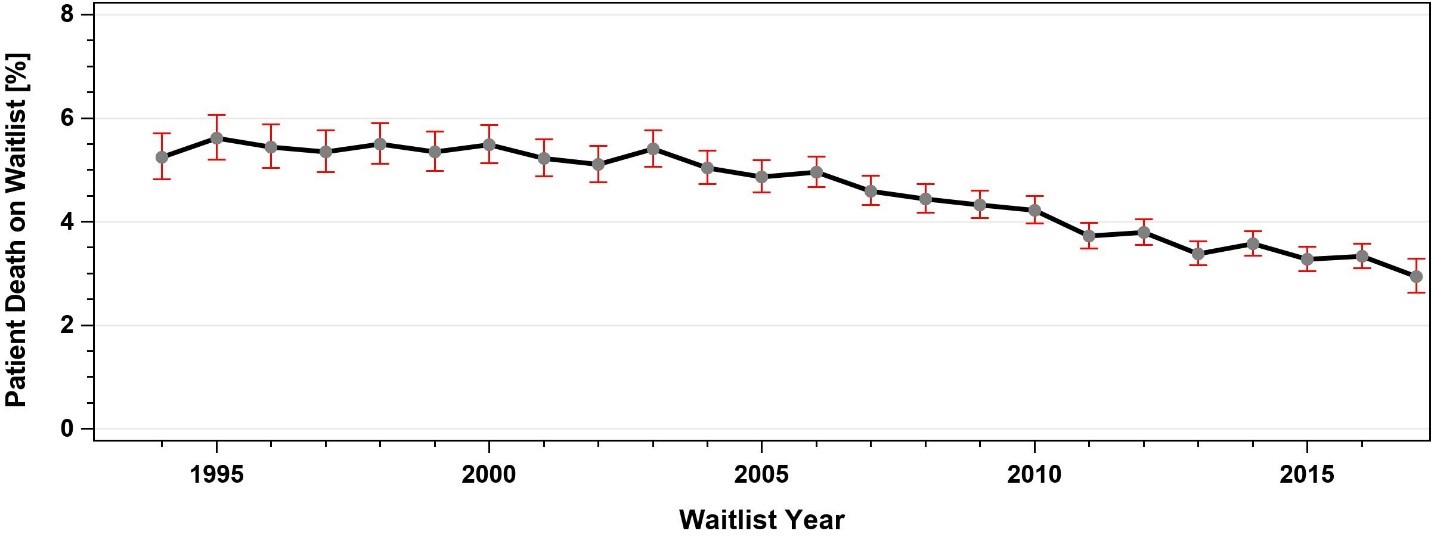Temporal Trends of First-Year Mortality on the Adult Kidney-Only Wait List in the United States
SUNY Downstate Medical Center, Brooklyn, NY
Meeting: 2019 American Transplant Congress
Abstract number: A216
Keywords: Kidney transplantation, Mortality, Waiting lists
Session Information
Session Name: Poster Session A: Kidney Deceased Donor Allocation
Session Type: Poster Session
Date: Saturday, June 1, 2019
Session Time: 5:30pm-7:30pm
 Presentation Time: 5:30pm-7:30pm
Presentation Time: 5:30pm-7:30pm
Location: Hall C & D
*Purpose: Evaluation of kidney transplant candidacy must balance risk of mortality with and without transplant. Trends in first-year mortality could inform patterns of risk avoidance over time.
*Methods: We used waitlist information collected in the UNOS/OPTN database from 1993 to 2017 and ascertained death against the Social Security Death Master File. First-year mortality was estimated by the Kaplan-Meier method censoring for wait-list removal or transplant within 12 months of listing. Possible predictors of first-year wait list mortality were compared using the chi-square test and Cox regression.
*Results: There were 563,070 adult kidney-only transplant candidates during the study period, of whom 19,767 (3.51%) died within a year of listing. First-year mortality fluctuated around 5-6% from 1993 to 2006 followed by sustained decline (Figure). In analysis of the period from 2006-17, there was statistically significant increase in age, a change in racial distribution, an increase in the proportion of candidates with type 1 or 2 diabetes and preemptive listings, and decrease in proportion of candidates with prior transplants. In Cox regression, the HR (hazard ratio) for death increased with increasing age compared to patients 18-30 years of age: HR (95% confidence interval [CI]) for age groups 31-45, 46-60, and 61 and above was 1.35 (1.29-1.53), 2.03 (1.80-2.29), and 3.20 (2.84-3.61), respectively. Dialysis at listing (HR 2.31 (2.19-2.43)), prior transplant (HR 1.66 (1.57 – 1.77)), and type 1 (HR 2.19 (2.03-2.37)) or 2 diabetes (HR 1.60 (1.53-1.68)) also predicted mortality. Blacks (HR 0.74 (0.7-0.77), Hispanics (HR 0.65 (0.6-0.7)), and subsequent years of listing (2008 HR 0.91 (0.86-0.97); 2010 HR 0.83 (0.77-0.88); 2012 HR 0.74 (0.7-0.79); 2014 HR 0.74 (0.69-0.79); 2016 HR 0.69 (0.64-0.75)) had lower risk of first-year mortality. Significant regional differences in waitlist mortality were also noted.
*Conclusions: Decreasing first-year mortality of adult kidney-only transplant candidates over the past decade was not explained by relative changes in the burden of comorbid conditions.
To cite this abstract in AMA style:
Tedla F, Gruessner A, Puri I, Brar A, Sumrani N, John D, Renz J, Gruessner R, Salifu M. Temporal Trends of First-Year Mortality on the Adult Kidney-Only Wait List in the United States [abstract]. Am J Transplant. 2019; 19 (suppl 3). https://atcmeetingabstracts.com/abstract/temporal-trends-of-first-year-mortality-on-the-adult-kidney-only-wait-list-in-the-united-states/. Accessed December 29, 2025.« Back to 2019 American Transplant Congress

